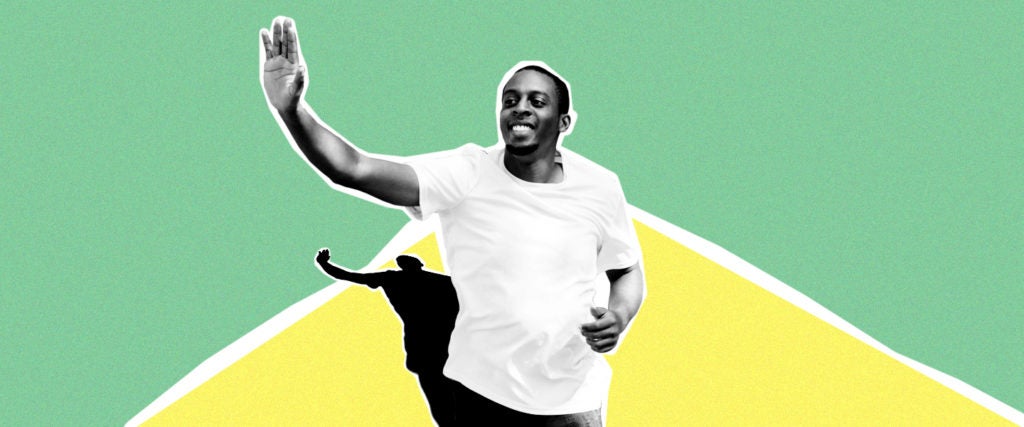Lisa, a 33-year-old in New Jersey, makes it a point to acknowledge every runner she passes during her own daily runs. Despite the fact that most of them don’t wave back, she feels a sense of duty in communicating that they’re not alone in the effort they’re making.
Such is Lisa’s burden — and that of her fellow waving-runners. It would seem that all runners love to receive a wave — scientifically speaking, it might even boost their performance — but there aren’t many who initiate the exchange. “A lot of us in my town commute into Manhattan, or did anyway, so I chalk up non-wavers to the ‘Manhattan Effect,’ which is that you’re so used to being hassled, catcalled or harassed that you get really good at just staring straight ahead with a mildly unpleasant, unapproachable look on your face,” Lisa laughs.
In 2016, Mizuno ran a poll of 1,000 runners and found that nearly 89 percent of them do indeed acknowledge other runners in some form or fashion, with a third doing so by waving. Over the years, people have also wondered about a host of other issues related to intra-runner communication — e.g., what influence does location have (per Per Lisa’s experience, New York runners are less likely to wave than those in Texas and Florida), how much does time of day and/or weather factor in, and maybe most importantly, should it happen at all?
I’m the guy who waves at every other runner in town (sometimes multiple times on a run). Is this accepted? from running
“Ultimately, it’s great to wave, but not necessary,” explains longtime marathon runner Paul Ronto. “If it’s super hot and you want to salute each other for the suffer-fest you’re enduring, go for it. Or if you’re on a narrow track in the woods and you pass someone, obviously proximity requires some sort of human interaction as well.”
In short, some might see runners’ waves as being in the same league as the “Jeep wave,” but Ronto advises runners not to feel obligated to wave to each other “as if we’re in some sort of secret community.”
After all, runners wouldn’t want to stoop to the level of hierarchy-obsessed bikers. “Bikers have this habit, too — they wave to other bikers, but road bikers tend to only wave back at other road bikers. It’s as if their fat-tired cousins are lower on the social stratus so they can be ignored because they aren’t wearing spandex onesies, and in turn, aren’t ‘real’ bikers or something,” Ronto jokes.
Perhaps, though, the issue is that runners just haven’t found the right signal. For example, in an attempt to get more reactions, Lisa tried the two-fingered peace sign for awhile. “But I kept flashing them with the wrong hand, so it’d be the back of my hand to the runner, and I’d get paranoid that both fingers weren’t totally up and visible so maybe they think I just flipped them off,” she explains.
She also tried the simple head head nod, but “the problem with nodding is when you’re doing an activity that already has you bobbing up and down, bobbing your head up and down is easy for someone to miss.”
Everytime I see a dog on a run I cant help but smile, wave, and pick up the pace a little knowing that dog believes in me from running
Luckily, she recently found something that appears to have done the trick. “Of all the different things I’ve tried, doing the ‘hang loose’ sign is the most successful,” she tells me. “No one mistakes it for a middle finger, it’s unnatural enough of a position that people won’t miss it, and if you twist your wrist back and forth while doing it in true ‘hang-loose’ fashion, it draws even more attention.”
Many runners agree, as explained by redditor sasspergillus last week. “I live in a big city, and I like to run alone at night. I was out for a run and saw another runner, a pretty big man, coming toward me. I’ve never had issues with fellow runners so I wasn’t nervous, but I try to keep my wits about me whenever any unknown person is approaching and I’m aIone,” the 37-year-old wrote. “As he passed, he quietly gestured ?and ran on. It was the absolute perfect way to say, ‘Fuck yeah, nice job’ — the perfect way to acknowledge me without making me feel weird or second guess the interaction. I didn’t feel intruded upon, hit on or pressured to respond. I felt seen in a way that didn’t make me feel vulnerable. I smiled for the rest of my run.”
But even with this groundbreaking development, Lisa understands that she’ll still likely be ignored by the majority of runners in her area. Which, again, is just fine by her. “While I like a good wave and that’s nice, some people are just out there wanting to do their own thing and value their runs as me-time, a time where they don’t need to be ‘on’ for anyone else, or be anything for anyone else — and that includes feeling obligated to wave or ‘hang loose’ back.”

